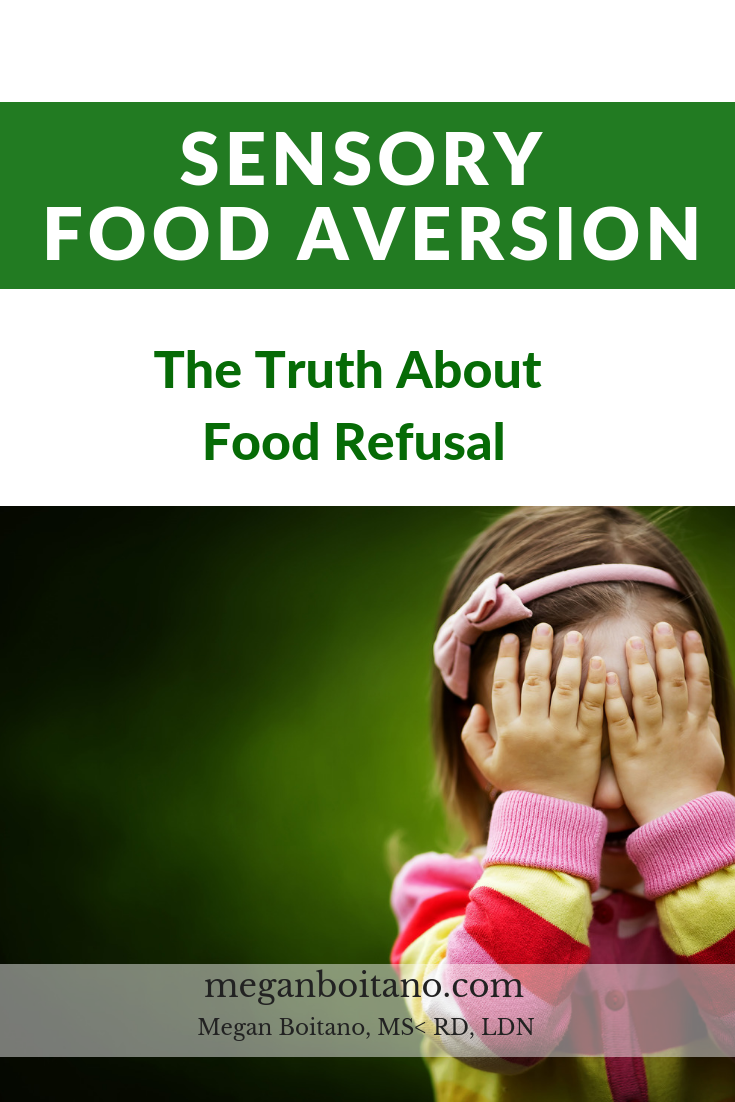Are you wondering if your child’s eating behaviors are signs of a sensory food aversion?
If your toddler will only eat crunchy foods like veggie straws or fish-shaped crackers, you know how frustrating and concerning it can be. Struggles with refusing textures like meats and vegetables can leave you seeking answers.
Before we dive into what to do to help your child, we need to better understand exactly what a sensory food aversion is and other possible explanations for your child’s behavior.
What is a Sensory Food Aversion?
When eating, you are exposed to a significant number of sensory inputs. From visual appearance of food, smell, temperature, taste and texture, eating is a demanding experience from a sensory perspective.
Some children are over (or under) responsive to the sensory elements of food and eating. This can mean gagging at the sight or smell of certain foods. It can also be vomiting or spitting food out.
Sensory food aversion can occur for many reasons, but often it is the result of difficulty processing the sensory aspects of eating. Children with an aversion are often labeled as picky or selective eaters.
Food Aversion and Sensory Processing Disorder
While sensory food aversion does occur in children with sensory processing disorder (SPD), having strong food aversions does not mean your child has SPD. However, it has been found that selective eating and feeding issues are more common in autism spectrum disorder and often are identified prior to diagnosis (1-2).
If you are concerned about your child’s sensory responses, be sure to talk to your pediatrician. For children with SPD, the responses are often not limited to food. There might be an inability to tolerate clothing made of certain fabrics, difficulty with brushing teeth, or even loud sounds such as an ambulance.
For sensory related feeding issues, an Occupational Therapist can offer specific strategies and serve as a valuable resource to support feeding therapy efforts. A pediatric Registered Dietitian with advanced skills in working with sensory feeding issues can help to create a comprehensive plan for your child.
Oral Motor vs Sensory Aversion
While the sensory elements alone are overwhelming and can result in the aversions you may be observing in your toddler, they alone may not be the culprit.
There are oral-motor issues that can result in food aversion. In order to effectively eat foods like vegetables and meats, you need specific skills. These include the ability to move the jaw to chew effectively, use the tongue to position food on the molar surfaces and place the chewed food in the right spot to swallow.
When children lack the skills to handle foods, they will refuse, gag, vomit or spit out the food. Foods that require limited oral-motor skills such as crunchy foods that melt easily when chewed, are often preferred.
As a parent, it can be hard to know what to do when you child gags excessively or vomits when trying new foods. The reason for the behavior can often be complex. Talk to your child’s pediatrician about symptoms you are seeing and ask for help.
A Speech Language Pathologist is the expert in oral-motor skills for chewing and swallowing. They can determine if your child is having any issues with skills such as using the tongue to position and chew foods. If needed, they can provide specific therapy to help.
Working with a pediatric Registered Dietitian that is skilled in feeding issues can help to provide you with support to select foods and ensure that your child’s nutritional intake is adequate while undergoing therapy to build skills.
Helping Children with Sensory Food Aversion
Research on the topic of treating food aversions is limited. Along with intervention when needed from Speech and Occupational therapists, there are some common approaches to address sensory food aversions.
Sensory-Based Food Play
For toddlers, this is often done through play. Sensory related food play is a way to help your child get more comfortable with sensory experiences.
The approach needs to be customized as each child will have different reactions to foods. One example might be using a napkin to play pee-a-boo with a food that causes a strong visual sensory reaction. Small glimpses of the food may be tolerated, and over time, the visual interaction with the food can be lengthened.
Often tactile stimulation or touching specific food textures can be problematic. Placing food in plastic bags and drawing letters or shapes is one approach that can be effective. Another is using an object such as a stick-shaped vegetable to touch or manipulate unfamiliar foods.
Creating a play scheme that is tailored to your child’s age and sensory profile is an important for sensory-based food play. You don’t want to overwhelm your child and exacerbate the sensory reaction.
Working with a pediatric Registered Dietitian with skills in play-based feeding therapy can help you work simultaneously on improving food selections and reducing aversions to foods.
Food Chaining
Another approach to help children with food aversion try new foods is using food chaining. This can help with the day-to-stay struggles of deciding what to feed your child and help to expand the foods accepted.
A food chain leverages information about the texture, taste and visual appearance of foods. With a complete map of your child’s food preferences (often sensory related), you can select foods that have the highest likelihood of being accepted.
This approach eliminates power struggles and forcing your child to try new foods. It allows you to slowly and gradually make changes to accepted foods. The result is an expanded list of foods your child will eat.
Summary
Sensory food aversion is complex and as a parent can be frustrating.
Often, your child will be labeled as a picky eater or you will be told to just keep offering your child the foods that are being refused.
Expert intervention and specialized approaches to help children with food aversions can have a significant positive impact on both stress for parents and overall diet quality.
Next Steps
For individualized help with your child, book a complimentary new client discovery call. You can help your child become a happy, healthy eater with the doubt and struggle!
Get your FREE Picky Eater Survival Guide
Click the button below to download your copy of the guide.
References:
Chistol LT, Bandini LG et. al. Sensory Sensitivity and Food Selectivity in Children with Autism Spectrum Disorder. J Autism Dev Disord. 2018 February ; 48(2): 583–591. doi:10.1007/s10803-017-3340-9.
Beighley JS, Matson JL, Rieske RD et. al. Food Selectivity in Children with and Without an Autism Spectrum Disorder: Investigation of Diagnosis and Age. Res Dev Disabil. 2013 Oct;34(10):3497-503. doi: 10.1016/j.ridd.2013.07.026.


